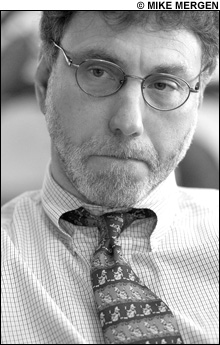
TOUGH TALK: Marty Baron is quick to criticize and slow to praise, but he may need to turn a critical eye on himself.
|
If the Big Dig tunnel collapse that killed Milena Del Valle on July 10 is the biggest Boston news story of 2006, the media story of the year is the Globe reporting — incorrectly — that a safety officer at the site all but predicted Del Valle’s death back in 1999, only to be ignored by his employer at the time, contractor Modern Continental.
But that botched media account itself remains an open case. Three months after John J. Keaveney was utterly discredited as a whistleblower, the Globe has yet to explain how it came to be suckered by a serial liar. Here’s why the paper hasn’t yet come clean — and why it might never do so.
Too good to be true
Even now, it’s possible to appreciate the seductive quality of Keaveney’s tale. Essentially, Keaveney took an already tragic situation and made it even more painful. Reading the Globe’s description of his alleged warning offered a kind of masochistic satisfaction; it was like pressing a fresh wound, just to make it hurt a bit worse.
No surprise, then, that the July 26 story quickly became the talk of Boston. In Keaveney’s note — which was dated May 17, 1999, supposedly mailed to the Globe without his knowledge, and received on July 25 — he warned Modern Continental that the epoxy-fastened bolts in the tunnel where Del Valle was killed might not hold the ceiling’s 2.5-ton panels. “Should any innocent State Worker [sic] or member of the Public be seriously injured or even worse killed as a result,” he wrote, “I feel that this would be something that would reflect Mentally and Emotionally upon me, and all who are trying to construct a quality Project.” Riveting stuff, worthy of A-1, top-of-the-fold placement. But the clincher came after the jump, where reporter Sean P. Murphy described the epiphany behind Keaveney’s warning:
He said he really began to worry about the ceiling after a third-grade class from his hometown of Norwell came to visit the Big Dig for a tour in spring 1999. He showed the class some concrete panels and pointed to the bolts protruding from the ceiling, explaining that the panels would one day hang from these bolts.
A third-grade girl raised her hand and asked him, ‘Will those things hold up the concrete?’
He started voicing concerns among his colleagues and then to managers after that. ‘It was like the [third graders] had pointed out the emperor has no clothes,’ he said. ‘I said, “Yes, it would hold,” but then I thought about it.’
Over the next few days, however, Keaveney’s story crumbled under the weight of serial inconsistencies and falsehoods. As late as August 4, when a note from Editor Marty Baron appeared in the Globe, the paper seemed to hold out hope that Keaveney and his memo might be vindicated. But the revelations that preceded Baron’s note (key engineering details included in Keaveney’s memo didn’t yet exist at the time he purportedly wrote it; he eventually admitted mailing the document to the Globe himself) and followed it (Keaveney had once been accused of assault; his résumé was filled with fabrications; he’d been fired by his most recent employer) left him with no credibility whatsoever.
ADVERTISEMENT
 |
In his August 4 editor’s note, Baron defended the Globe’s decision to publish the July 26 story, which ran even though Modern Continental hadn’t had an opportunity to rebut Keaveney’s claim — something the paper’s own ethics code requires. But Baron also vowed that the paper would aggressively cover the Keaveney story in the future. “The Globe will continue to report fully and forthrightly on this matter,” he wrote, “bringing to our readers everything we learn.”
Today, however, this promise seems not to have been kept. For starters, it needs to be said that the Herald, which loves gloating over Globe gaffes, covered the story more effectively in the days that followed. (The Herald broke the news that Keaveney had once been accused of assault, and was the first to note that his résumé included false claims about his education and military experience.) What’s more, the Globe never actually issued a final verdict on the authenticity of Keaveney’s memo. At this point, it’s hard to find anyone in Boston who doesn’t think it was a fake. But the Globe still hasn’t said it was hoodwinked.
When it comes to sizing up the Globe’s performance, though, the most important story may be one that was never actually published. According to sources inside the paper, a hefty Keaveney profile by ace reporter Donovan Slack — which could have put the entire affair to rest — sat on the news budget for several weeks in August. It didn’t run, however, and was eventually dropped off the budget.